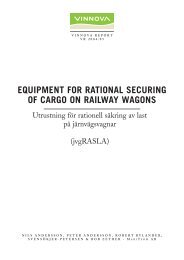Download - Autosim Autosim
Download - Autosim Autosim
Download - Autosim Autosim
You also want an ePaper? Increase the reach of your titles
YUMPU automatically turns print PDFs into web optimized ePapers that Google loves.
THE AUTOSIM PROJECT<br />
4.5.7 Design-to-Cost<br />
Functional Requirement and Cost Trade-off studies using Parameterized<br />
Vehicle Concepts in the Early Design Phase.<br />
Affordability is one of the key issues for design engineers and<br />
manufacturers of new car body models. Sometimes vehicle development<br />
projects have failed to enter the production phase because cost was not<br />
factored in during the early development phase and it was realized later that<br />
the vehicle program could not meet the projected financial targets. Likewise,<br />
many vehicle projects that went into production with severe cost and<br />
manufacturing constraints failed in the marketplace because of limited<br />
improvement in vehicle functionality or performance. Either case is due<br />
primarily to the lack of understanding of the cost and performance<br />
relationship and engineering alternatives during the vehicle development<br />
cycle (Ref. [18], [19]).<br />
To stay competitive, it is becoming vital to include cost engineering at every<br />
stage of a new program to ensure success in achieving performance targets<br />
while managing cost. Cost engineering has been applied in recent years<br />
starting in the aerospace and defence industries and researched<br />
continuously by academia.<br />
Several enabling technologies have been developed over the years such<br />
that it is now possible to bring cost engineering into the modern simulationbased<br />
development process for vehicle body structure in the early concept<br />
stage. These include:<br />
1) Reasonably accurate performance models based on finite element<br />
techniques<br />
2) Capable cost estimating tools, with commercial or in-house<br />
developed tools.<br />
3) Parametric concept development systems that allow for fast<br />
changes of concept geometry and the associated computational<br />
models.<br />
4) A process integration and computational framework that can flexibly<br />
integrate simulation models and cost models into a simulationbased<br />
design iteration loop to study cost-performance trade-off.<br />
Fig.4.5.7.1 shows a schematic workflow of such a system that can be<br />
applied to automotive body design. Changing the architecture features will<br />
trigger changes in cost estimates of materials and manufacturing.<br />
SIXTH FRAMEWORK PROGRAMME PRIORITY [6.2] [SUSTAINABLE SURFACE TRANSPORT]<br />
012497 AUTOSIM<br />
57 |
















